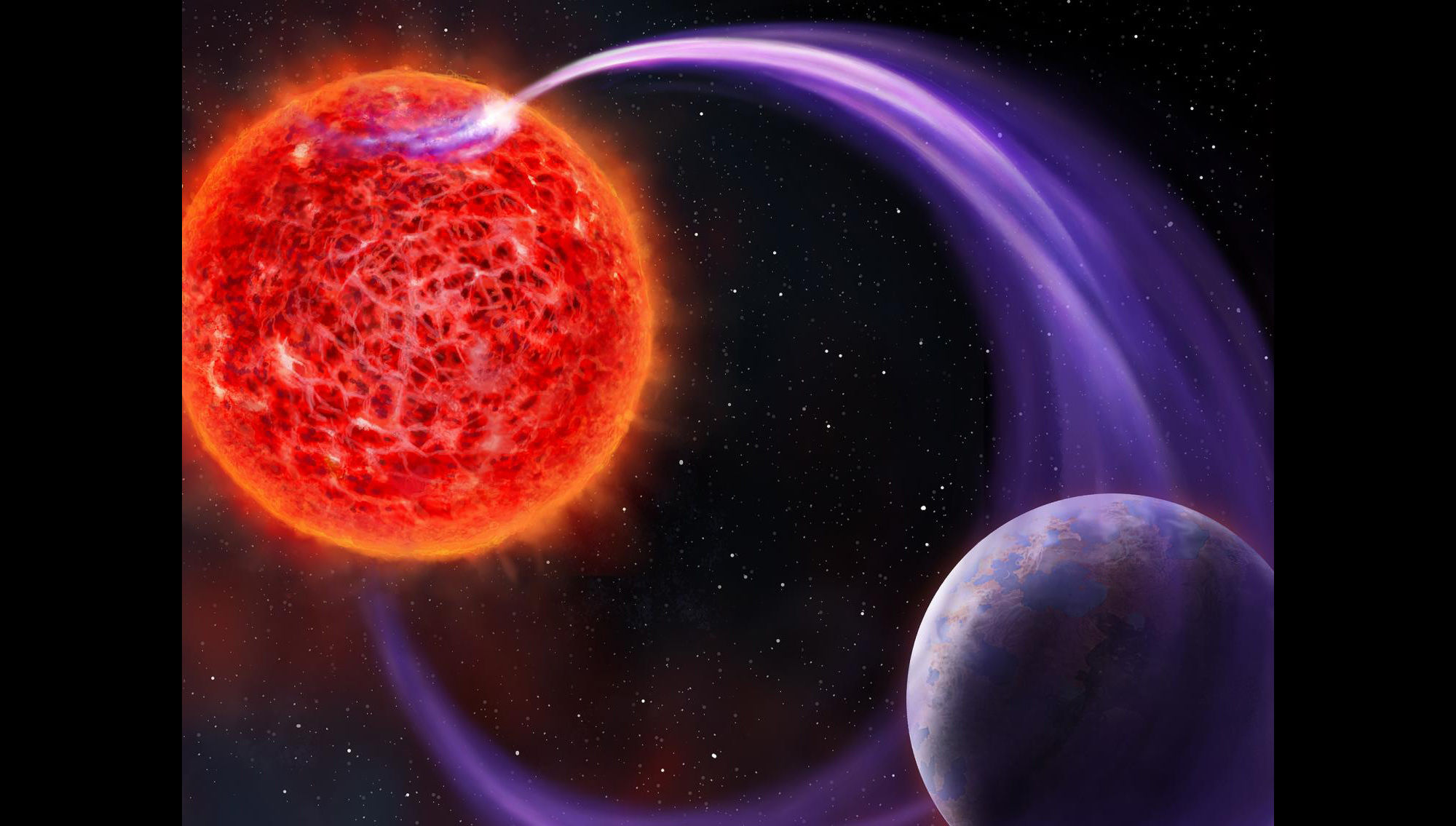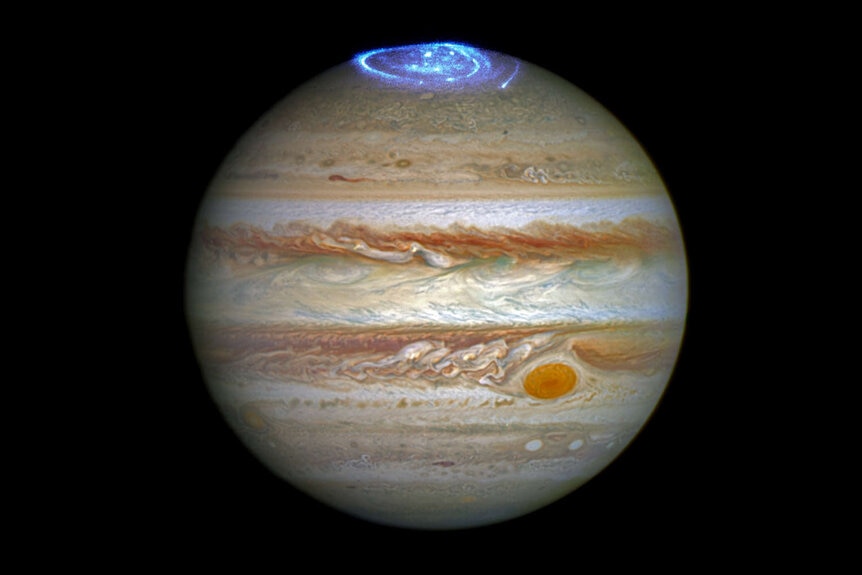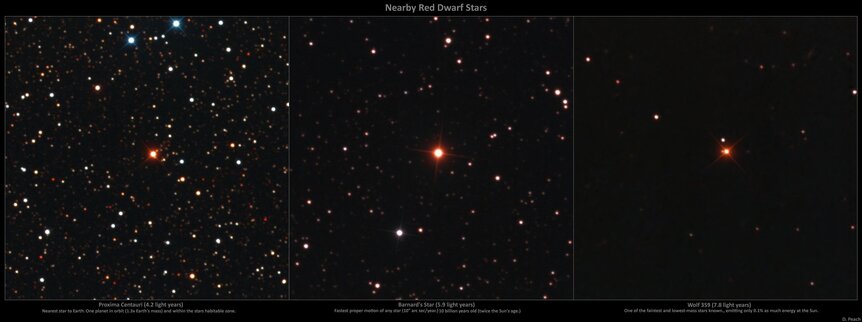Create a free profile to get unlimited access to exclusive videos, sweepstakes, and more!
Astronomers find 17 red dwarf stars that may have aurorae triggered by orbiting Earth-sized planets

Following up on work presented last year with a single star, a team of astronomers has found evidence for planets orbiting quite a few nearby red dwarf stars, and they’ve done it in an entirely new way: By looking for aurorae on the stars themselves.
An aurora on Earth is caused when electrically charged subatomic particle (like electrons) in the Sun’s solar wind stream past the Earth and are caught by our planet’s magnetic field. The mechanism is pretty complex but in a nutshell these particles are funneled down to the Earth’s magnetic poles (which coincide closely with the physical poles) where they slam into our air at extremely high speeds. This strips the electrons off the atoms and molecules in our atmosphere, and when they recombine the atoms visibly glow, creating the northern and southern lights. This also emits radio wave energy, too.
… but there’s another way for this to happen, and it’s the key to the new work. Jupiter’s moon Io is extremely volcanic. It spews sulfur into space around it. Jupiter has a ridiculously strong magnetic field, and it strips electrons from those sulfur atoms, giving them an electric charge. These particles are then accelerated down the magnetic fields lines toward Jupiter, slam into its atmosphere, and create aurorae (in ultraviolet light in this case) that can be viewed from Earth. It also generates radio waves.
In the new research, the astronomers reasoned the same thing Jupiter and Io are doing may be happening with red dwarf stars. These are low-mass, cool, and faint stars, and are the most common kind of star in the Universe (the closest star to the Sun, Proxima Centauri, is a red dwarf).
They tend to have very strong magnetic fields, and they also tend to host terrestrial (rocky) planets very close in — a great example is TRAPPIST-1, a red dwarf just 40 light years from us that hosts seven tightly spaced Earth-sized planets. If some of those red dwarf planets have magnetic fields, they could be connected to their host stars in the same way Io is connected to Jupiter. If that’s the case, then they might induce an aurora on those red dwarfs just like Io does on Jupiter.
The visible/ultraviolet light emitted by such a connection would be nearly impossible to find, but the low frequency radio waves can in principle be detected using a very sensitive radio telescope looking at the right frequencies.
So the astronomers turned to LOFAR, the Low Frequency Array, a collection of thousands of small radio antennae spread out over the Netherlands (and connected to similar stations across Europe). It’s phenomenally sensitive at just the right frequency (144 MHz, or a wavelength of about two meters; visible light has a wavelength of less than a micron, a millionth of a meter) to look for the kind of radio emissions from such red dwarfs.
Happily, LOFAR is conducting a survey of the northern sky at that frequency, about 20% of which has been processed so far. Looking through it for strong sources, the astronomers cross-matched them with nearby red dwarfs seen by Gaia, another observatory which looks at over a billion stars in the Milky Way to get their exact positions and distances.
They found 19 such red dwarfs, ranging in distance from us of 13 to 156 light years (more distant red dwarfs are increasingly difficult to see). Of these, 17 emitted radio waves with the right properties to possibly be from planets interacting with their host stars magnetically!
As it happens, there are other ways for red dwarfs to emit radio waves, most of them generated by the magnetic field of the star itself. However, in nearly all cases, the magnetic fields or the stars themselves don’t have the right characteristics to generate the aurora-like emission (as an example, young stars rotate more rapidly, so their magnetic fields are stronger; most of the stars looked at here are slow rotators so they can’t generate the kinds of magnetic fields themselves to make this radio light). So in most cases the usual way red dwarfs make radio waves don’t work here, leaving behind planets as the most likely explanation.
That’s amazing. If true, it means this could be a new way to look for exoplanets. Instead of them transiting their stars, or tugging on them, or the dozen other ways we use now, this method would look for planets inducing aurorae on their parent stars. The survey from LOFAR is more sensitive than done before, but could be fantastically more sensitive if stars are targeted specifically and observed for long periods of time. In fact, that could help because the radio waves seen from such a star/planet system should change brightness as the planet orbits the star; sometimes the radio waves are aimed at us and sometimes they aren’t. This could be used to find the planets’ orbital periods, and possibly multiple planets orbiting one star. These terrestrial planets tend to orbit the star pretty close in in general (and they have to for the magnetic connection to be strong enough), which means this change would happen rapidly, over just hours or days. That makes it easier to see.
I’ll note that this same team published results last year where they focused in on one particular red dwarf : GJ 1151, which is just 26 light years way (for this first attempt they looked at very nearby red dwarfs). It showed radio emission with the right characteristics, including the fact that it was only seen once in four observations; that could be because the planet was only in the right position in its orbit for a short time to beam the waves at us, as would be expected.
This is very cool. I’ll gently remind you that the first exoplanet wasn’t detected until 1991, and progress was slow for a while. Now we have lots of ways of finding then, and over 4,500 have been confirmed so far. A new way to discover them just means we’ll add to that total even faster.
Our galaxy is full of planets, possibly outnumbering even stars in the sky, and red dwarfs make up roughly 80% of all stars in the Universe. Given the way things are going, I wonder how long it will be before our database will have millions of them. Billions.





























